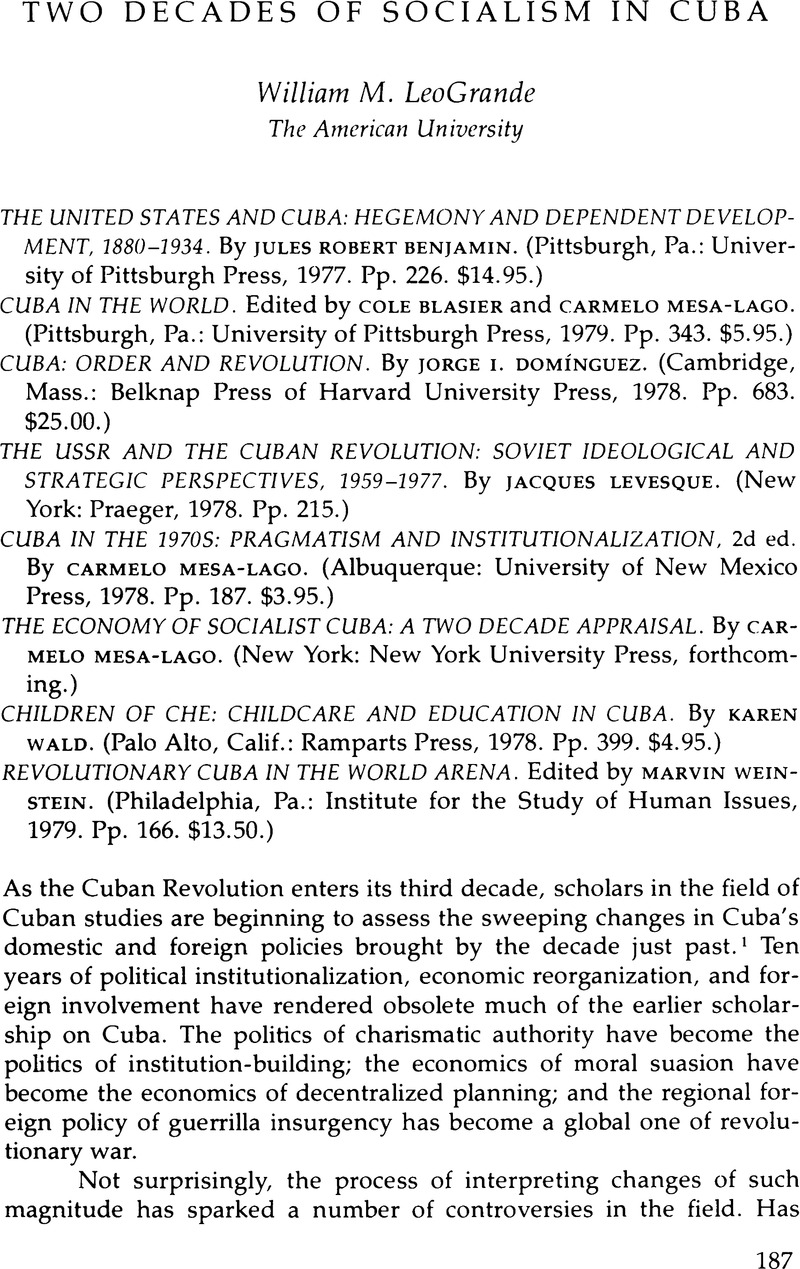Published online by Cambridge University Press: 24 October 2022

1. See, for example, the “Forum on Instinationalization,” Cuban Studies IEstudios Cubanos 9, no. 2 (July 1979): 63–90.
2. Heretofore, the standard work on the subject has been Robert Freeman Smith, The United States and Cuba: Business and Diplomacy, 1917–1960 (New Haven, Conn.: College and University Press, 1960). Though Benjamin offers more detail on some subjects, Smith is still the best overall study of the period.
3. For example, Abraham F. Lowenthal, “‘Liberal’, ‘Radical’, and ‘Bureaucratic’ Perspectives on U.S. Latin American Policy: The Alliance for Progress in Retrospect,” in Julio Cotler and Richard R. Fagen (eds.), Latin America and the United States: The Changing Political Realities (Stanford, Calif.: Stanford University Press, 1974), pp. 212–35.
4. Guillermo O'Donnell makes this point forcefully in his commentary on bureaucratic politics models in the Cotler and Fagen volume, “Commentary on May,” pp. 164–75.
5. See, for example, the exchanges in the special issue of Latin American Perspectives 1, no. 1 (Spring 1974) on dependency theory.
6. Luis E. Aguilar, Cuba 1933: Prologue to Revolution (New York: Norton, 1972) provides a good contrast. Though Aguilar's explanation of the revolution of 1933 is not as compelling as Benjamin's, Aguilar succeeds in providing the reader with a strong sense of domestic political cleavages and dynamics during that period.
7. Samuel P. Huntington, Political Order in Changing Societies (New Haven, Conn.: Yale University Press, 1968).
8. James O'Connor, The Origins of Socialism in Cuba (Ithaca, N.Y.: Cornell University Press, 1970) does regard the prerevolutionary system, especially under Batista, as corporatist.
9. O'Connor, The Origins, chapters 1–3.
10. For the major explication of this view, see Edward Gonzalez, Cuba under Castro: The Limits of Charisma (Boston, Mass.: Houghton-Mifflin, 1974).
11. Huntington, Political Order, pp. 12–22.
12. Ibid., pp. 334–43.
13. For example, D. Richard Little, “Mass Political Participation in the U.S. and the U.S.S.R.: A Conceptual Analysis,” Comparative Political Studies 8, no. 4 (Jan. 1976): 437–60; and Jerry F. Hough, The Soviet Union and Social Science Theory (Cambridge, Mass.: Harvard University Press, 1977).
14. The chapter on agrarian politics is unsurpassed. Not only is this an important and often overlooked aspect of Cuban politics, Domínguez's treatment of it is the best in the book.
15. Edward Gonzalez, “Institutionalization, Political Elites, and Foreign Policies,” in Blasier and Mesa-Lago (eds.), Cuba in the World; “The Party Congress and Poder Popular,” Cuban Studies Estudios Cubanos 6, no. 2 (July 1976): 1–14; “Complexities of Cuban Foreign Policy,” Problems of Communism 26 (Nov.–Dec. 1977:) 1–15; “Castro and Cuba's New Orthodoxy,” Problems of Communism 25 (Jan.–Feb. 1976): 1–19; “Comment,” Cuban Studies/Estudios Cubanos 9, no. 2 (July 1979): 80–81.
16. Gonzalez, Cuba Under Castro.
17. Gonzalez, “Castro and Cuba's New Orthodoxy,” pp. 12–16.
18. On the various factional divisions within the elite, see William M. LeoGrande, “Continuity and Change in the Cuban Political Elite,” Cuban Studies/Estudios Cubanos 8, no. 2 (July 1978): 1–33.
19. Max Azicri, “The Institutionalization of the Cuban Revolution: A Review of the Literature,” Cuban Studies/Estudios Cubanos 9, no. 2 (July 1979): 78–83; Lourdes Casal, “On Popular Power: The Organization of the Cuban State during the Period of Transition,” Latin American Perspectives 2, no. 4 (1979): 78–88; Casal, “Cuban Communist Party: The Best among the Good,” Cuba Review 6 (Sept. 1979): 23–30; Carollee Bengelsdorpf, “A Large School of Government,” Cuba Review 6 (Sept. 1976): 3–18; Marifeli Pérez-Stable, “Whither the Cuban Working Class?,” Latin American Perspectives 2, no. 4 (1975): 60–77; William M. LeoGrande “Mass Political Participation in Socialist Cuba,” in John A. Booth and Mitchell A. Seligson (eds.), Political Participation in Latin America (New York: Holmes and Meier, 1978).
20. On the limits of Cuban economic data, see Mesa-Lago's “Availability and Reliability of Statistics in Socialist Cuba,” LARR 4, nos. 1 and 2 (Spring and Summer 1969): 53–91, 47–81; and his brief update, “Cuban Statistics Revisited,” Cuban Studies/Estudios Cubanos 9, no. 2 (July 1979): 59–62.
21. For a more policy oriented analysis, see Archibald R. M. Ritter, The Economic Development of Revolutionary Cuba: Strategy and Performance (New York: Praeger, 1974).
22. Mesa-Lago originally dubbed this period the “Sino-Guevarist” model. Presumably the substitution reflects recent changes in the Chinese development model, specifically T'eng Hsiao-ping's retreat from Maoism, rather than any new assessment of Cuba's practice during the late 1960s.
23. Mesa-Lago first addressed these issues in “Economic Policies and Growth,” in Mesa-Lago (ed.), Revolutionary Change in Cuba (Pittsburgh, Penn.: Pittsburgh University Press, 1971).
24. For a somewhat different interpretation of essentially the same data, see William M. LeoGrande, “Cuban Dependency: A Comparison of Prerevolutionary and Post-revolutionary International Economic Relations,” Cuban Studies/Estudios Cubanos 9, no. 2 (July 1979): 1–28.
25. For example, after more than two pages detailing the shortcomings of contemporary Cuban education, Domínguez writes, “These criticisms … should not detract from the impressive educational achievements of the revolutionary government compared to the prerevolutionary period.” But there is no comparable discussion of what those achievements have been (pp. 170–72).
26. For more systematic assessments of childcare and educational policy, respectively, see Marvin Leiner, Children Are the Revolution: Day Care in Cuba (New York: Penguin, 1974); and Jonathan Kozol, Children of the Revolution (New York: Delacorte Press, 1978)
27. Lynn D. Bender, The Politics of Hostility (Hato Rey, Puerto Rico: Inter-American University Press, 1975).
28. For such an essay, see Jorge I. Domínguez, “Cuban Foreign Policy,” Foreign Affairs 57, no. 1 (1978): 83–108.
29. The January and July 1980 issues of Cuban Studies/Estudios Cubanos, still in press at this writing, are devoted entirely to Cuba's African policy.
30. Domínguez, p. 159; Mesa-Lago, Cuba in the 1970s, p. 105, Gonzalez “Castro and Cuba's New Orthodoxy.”
31. E.g., Nelson Valdes, “Revolution and Institutionalization in Cuba,” Cuban Studies: Estudios Cubanos 6, no. 1 (Jan. 1976): 1–24; William M. LeoGrande “Party Development in Revolutionary Cuba,” Journal of Interamerican Studies and World Affairs 21, no. 4 (Nov. 1979): 457–80.
32. E.g., Domínguez, “Cuban Foreign Policy”; Gonzalez's article in Blasier and Mesa-Lago (eds.); Mesa-Lago, Cuba in the 1970s, pp. 142f.